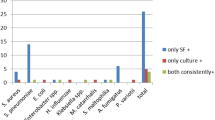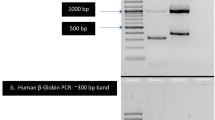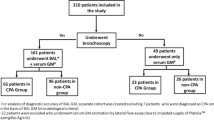Abstract
Invasive aspergillosis continues to be a significant cause of morbidity and mortality in solid organ transplant (SOT) recipients. A reliable and early diagnostic method is needed to improve survival. In this study, four methods direct microscopy, culture, nested PCR on internal transcribed spacer region, and TaqMan real-time PCR targeted β-tubulin gene were examined for the detection of Aspergillus fumigatus and A. flavus in sixty-four bronchoalveolar lavage (BAL) fluids that were obtained from SOT recipients. Direct examination with 20 % KOH (potassium hydroxide) and culture on mycological media were also performed. Of the 64 samples, seven (10.9 %) were positive in direct examination (five with septate hyphae and two with aseptate hyphae), and 15 (23 %) had positive culture including five A. flavus, four A. niger, two Penicillium spp., two Rhizopus spp., one Fusarium spp. and one mixed A. flavus/A. niger. Twenty five (39 %) samples had positive nested PCR with A. flavus and 6 (9.4 %) with A. fumigatus-specific primers. Only eight (12.5 %) had positive real-time PCR for A. flavus and nine (14 %) for A. fumigatus. The incidence of aspergillosis in these patients included proven invasive pulmonary aspergillosis (IPA) in two (3 %), probable IPA in 14 (22 %), possible IPA in 38 (59 %), and not IPA in 10 (16 %). A. flavus was the most common cause of pulmonary aspergillosis (PA) in the study. The results suggest that because nested PCR is too sensitive it may increase the number of false-positive results and is not recommended for BAL samples for diagnosis of PA. Although further studies with significant number of proved positive/negative standard BAL samples are necessary for better evaluation, the novel multiplex real-time PCR developed in the study could be promising as a valid diagnostic method for IPA.


Similar content being viewed by others
References
Soubani AO, Chandrasekar PH. The clinical spectrum of pulmonary aspergillosis. Chest. 2002;121:1988–99.
Segal BH, Walsh TJ. Current approaches to diagnosis and treatment of invasive aspergillosis. Am J Respir Crit Care Med. 2006;173:707–17.
Silveira FP, Husain S. Fungal infections in solid organ transplantation. Med Mycol. 2007;45:305–20.
Singh N, Paterson DL. Aspergillus infections in transplant recipients. Clin Microbiol Rev. 2005;18:44–69.
Rubin RH. Infection in the organ transplant recipient. In: Rubin RH, Young LS, editors. Clinical Approach to Infection in the Compromised Host. New York: Kluwer/Plenum Publishers; 2002. p. 573–679.
Gavalda J, Len O. San Juan R, et al. Risk factors for invasive aspergillosis in solid-organ transplant recipients: a case-control study. Clin Infect Dis. 2005;41:52–9.
Morgan J, Wannemuehler KA, Marr KA, et al. Incidence of invasive aspergillosis following hematopoietic stem cell and solid organ transplantation: interim results of a prospective multicenter surveillance program. Med Mycol. 2005;43:49–58.
Zaas AK, Alexander BD. Invasive pulmonary aspergillosis. In: Latge JP, Steinbach WJ, editors. Aspergillus fumigatus and aspergillosis. Washington: ASM Press; 2009. p. 293–300.
Denning DW. Invasive aspergillosis. Clin Infect Dis. 1998;26:781–803.
Denning DW. Diagnosis and management of invasive aspergillosis. Curr Clin Top Infect Dis. 1996;16:277–99.
Knox KS, Meinke L. Role of bronchoalveolar lavage diagnostics in fungal infections. Clin Chest Med. 2009;30:355–65.
Lass-Flörl C, Freund MC. Diagnosing Aspergillosis: the role of invasive diagnostic interventions. In: Pasqualotto AC, editor. Aspergillosis: from diagnosis to prevention. New York: Springer press; 2010. p. 391.
Tuon FF. A systematic literature review on the diagnosis of invasive aspergillosis using polymerase chain reaction (PCR) from bronchoalveolar lavage clinical samples. Rev Iberoam Micol. 2007;24(2):89–94.
Hayette MP, Vaira D, Susin F, et al. Detection of Aspergillus species DNA by PCR in bronchoalveolar lavage fluid. J Clin Microbiol. 2001;39(6):2338–40.
Sanguinetti M, Posteraro B, Pagano L, et al. Comparison of real-time PCR, conventional PCR, and galactomannan antigen detection by enzyme-Linked immunosorbent assay using bronchoalveolar lavage fluid samples from hematology patients for diagnosis of invasive pulmonary aspergillosis. J Clin Microbiol. 2003;41:3922–5.
Buchheidt D, Hummel M, Schleiermacher D, et al. Prospective clinical evaluation of a LightCycler-mediated polymerase chain reaction assay, a nested PCR assay and a galactomannan enzyme-linked immunosorbent assay for detection of invasive aspergillosis in neutropenic cancer patients and haematological stem cell transplant recipients. Br J Haematol. 2004;125:196–202.
Baxter CG, Jones AM, Webb K, Denning DW. Homogenisation of cystic fibrosis sputum by sonication: An essential step for Aspergillus PCR. J Micro Meth. 2011;85:75–81.
Makimura K, Tamura Y, Mochizuki T, Hasegawa A, Tajiri Y, Hanazawa R, Uchida K, Saito H, Yamaguchi H. Phylogenetic classification and species identification of dermatophyte strains based on DNA sequences of nuclear ribosomal internal transcribed spacer 1 regions. J Clin Microbiol. 1999;37(4):920–4.
Sugita C, Makimura K, Uchida K, Yamaguchi H, Nagai A. PCR identification system for the genus Aspergillus and three major pathogenic species: Aspergillus fumigatus, Aspergillus flavus and Aspergillus niger. Med Mycol. 2004;42:433–7.
Pauw BD, Walsh TJ, Donnelly JP, et al. Revised definitions of invasive fungal disease from the European Organization for Research and Treatment of Cancer/Invasive Fungal Infections Cooperative Group and the National Institute of Allergy and Infectious Diseases Mycoses Study Group (EORTC/MSG) Consensus Group. Clin Infect Dis. 2008;46:1813–21.
Horvath JA, Dummer S. The use of respiratory-tract cultures in the diagnosis of invasive pulmonary aspergillosis. Am J Med. 1996;100:171–8.
Buchheidt D, Baust C, Skladny H, et al. Detection of Aspergillus species in blood and bronchoalveolar lavage samples from immunocompromised patients by means of 2-step polymerase chain reaction: clinical results. Clin Infect Dis. 2002;33:428–35.
Hohl TM, Feldmesser M. Aspergillus fumigatus: principles of pathogenesis and host defense. Euka Cell. 2007;6:1953–63.
Rementeria A, Lopez-Molina N, Ludwig A, et al. Genes and molecules involved in Aspergillus fumigatus virulence. Rev Iberoam Micol. 2005;22:1–23.
Badiee P, Alborzi A. Detection of Aspergillus species in bone marrow transplant patients. J Infect Dev Ctries. 2010;4(8):511–6.
Zarrinfar H, Saber S, Kordbacheh P, Makimura K, Fata A, Geramishoar M, Mirhendi H. Mycological microscopic and culture examination of 400 Bronchoalveolar Lavage (BAL) samples. Iran J Publ Health. 2012;41:70–6.
Zarrinfar H, Makimura K, Satoh K, Khodadadi H, Mirhendi H. Incidence of pulmonary Aspergillosis and correlation of conventional diagnostic methods with nested PCR and Real-Time PCR Assay using BAL fluid in intensive care unit patients. J Clin Lab Anal. 2013;27:181–5.
Hedayati MT, Mayahi S, Denning DW. A study on Aspergillus species in houses of asthmatic patients from Sari City, Iran and a brief review of the health effects of exposure to indoor Aspergillus. Environ Monit Assess. 2010;168(1–4):481–7.
Krishnan S, Manavathu EK, Chandrasekar PH. Aspergillus flavus: an emerging non-fumigatus Aspergillus species of significance. Mycoses. 2009;52:206–22.
Steinbach WJ. Pediatric aspergillosis: diagnosis and treatment differences in children. Pediatr Infect Dis J. 2005;24:358–64.
Rantakokko-Jalava K, Laaksonen S, Issakainen J, et al. Semiquantitative detection by real-time PCR of Aspergillus fumigatus in bronchoalveolar lavage fluids and tissue biopsy specimens from patients with invasive aspergillosis. J Clin Microbiol. 2003;41:4304–11.
Zmeili OS, Soubani AO. Pulmonary aspergillosis: a clinical update. Q J Med. 2007;100:317–34.
Ruhnke M, Bohme A, Buchheidt D, et al. Diagnosis of invasive fungal infections in hematology and oncology–guidelines of the Infectious Diseases Working Party (AGIHO) of the German Society of Hematology and Oncology (DGHO). Ann Hematol. 2003;82:141–8.
Oren I, Goldstein N. Invasive pulmonary aspergillosis. Curr Opin Pulm Med. 2002;8:195–200.
Acknowledgments
We thank the staff of Teikyo University Institute of Medical Mycology (TIMM) in Japan and all personnel at respiratory ward of Shariati Hospital and Medical Mycology laboratory in School of Public Health in Tehran University of Medical Sciences (TUMS), for their helps.
Author information
Authors and Affiliations
Corresponding author
Rights and permissions
About this article
Cite this article
Zarrinfar, H., Mirhendi, H., Makimura, K. et al. Use of Mycological, nested PCR, and Real-time PCR Methods on BAL Fluids for Detection of Aspergillus fumigatus and A. flavus in Solid Organ Transplant Recipients. Mycopathologia 176, 377–385 (2013). https://doi.org/10.1007/s11046-013-9657-9
Received:
Accepted:
Published:
Issue Date:
DOI: https://doi.org/10.1007/s11046-013-9657-9




